Dr Rajesh Pradhanang obituary: A socially responsible homeopathic doctor
Birth: 25 October 1967, Kathmandu
Death: 12 December 2021, Lalitpur
For Dr Rajesh Pradhanang, his father, Dr Krishna Bhakta Pradhanang, a homeopathic doctor, was a role model whose footsteps he wanted to follow on.
But this was not the only reason the son wanted to pursue homeopathy. Even though the homeopathic system of medicine had been used in Nepal for at least a century, it had not gained much traction due to the lack of physicians. So, Pradhanang took it as a challenge to establish homeopathy as a respectable profession in Nepal.
As soon as he completed his Intermediate of Science degree from Amrit Science College in 1987, Pradhanang went to India and joined a Diploma in Homeopathic Medicine and Surgery course at Pratap Chandra Memorial Homeopathic Medical College and Hospital.
In the same year, he returned to Nepal with a certificate and started a private clinic. This he did on October 29, the birthday of his teacher, Dr DJ Sutarwala. He also started a free homeopathic dispensary at Thai Kirti Monastery, Kirtipur.
In 2005, Pradhanang established the Buddha Maitreya Soul Therapy Center in Thamel, which treats maladies with light and music. The treatment is a combination of spiritual and medical healing—the first of its kind in Nepal.
Also read: Dr. Subash Lohani obituary: A spiritual neurosurgeon
He organized numerous free health and wellness camps in rural areas of Nepal to establish a positive perception about homeopathy and to help people benefit from medical and spiritual practices. Pradhanang was also keen to work in the field of child psychology. He thought children, the future of the nation, should be healthy if the country is to progress.
During the 2015 earthquake, he managed shelter and food for many affected people with the help of different Buddhist institutions and schools.
To spread awareness about the benefits of homeopathy, he also started to write health columns in newspapers, magazines, and run TV shows. Pradhanang’s work has appeared in over two dozen media outlets over the past two decades. Every few years, he used to get an invite from the International Council for Homeopathy to help organize its world conference and to prepare a homeopathic book.
Recognizing his contribution, Nepal Cancer Relief Society and Nepal Orthopedic Hospital had even awarded him.
A couple of weeks ago, Pradhanang and his wife tested positive for Covid-19. They had developed severe symptoms and were rushed to hospital. His wife got discharged after successfully defeating the virus a few days later, but he succumbed. The 54-year-old is survived by his wife, a daughter, and a son.
Nimsdai: The man who went beyond the possible
I am pretty sure that most of you have already watched ‘14 Peaks: Nothing is Impossible’—the Netflix documentary on Nirmal Purja (Nimsdai) about his record-breaking mountain expedition: Project Possible 14/7.
The documentary released on 26 November 2021 has become one of the most watched films of the week on Netflix. It is on the seventh position globally with over 12 million hours of watchtime and received an 8.2 rating on IMDb.
Born in Myagdi to a lower-middle-class family that moved to Chitwan, Purja was surrounded by Gurkha soldiers in the family. He also joined the Brigade of Gurkhas in 2003 and was accepted into the Royal Navy’s Special Boat Service (SBS) in 2009, becoming the first Gurkha to join the elite British unit. He further served in Special Boat Service as a cold-weather warfare specialist and Special Air Service (SAS) unit.
Purja first got into mountaineering in 2012 when he summited Lobuche (6,119m) and Dhaulagiri in 2014. He summited the highest peak in the world, Everest in 2016. Even at this point, he did not think of bidding adieu to the military.
In 2017, he completed the Everest-Lhotse-Makalu summit within five days. “I later realized I could have done it in three days, had I not rested,” he says on the idea of climbing all 14 peaks in the world above 8,000m in less than seven months. The previous record for the same feat was nearly eight years, but he did it in just six months and six days. “A lot of people didn’t believe me at the time when I shared my idea,” he adds.
Also read: Dr Garima Shrestha: A doctor treating social taboos
For Project Possible 14/7, Nimsdai was accompanied by Mingma David Sherpa, Lakpa Dendi, Geljen Sherpa, and Tensi Kasang, among other mountaineers. They started with Annapurna on 23 April 2019, and on 24 May 2019, they had completed climbing six of the mountains, completing phase I. This time, he broke his own world record by climbing Mt Everest, Lhotse, and Makalu in 2 days and 30 minutes.
The second phase of his project took him to Pakistan where he had to summit five peaks, including the deadly K2 and Nanga Parbat. Nimsdai and his team made another world record by climbing K2 on 24 July 2019—the first-ever winter ascent. Numerous climbers had failed to do so since the first attempt in 1987. Also, he was the only team member to the summit without the use of supplemental oxygen, becoming the first individual to do so in history.
Many other climbers suggested he should halt the project due to unfavorable weather conditions before phase I, but every time, his reply was “Giving up is not in the blood, sir. It’s not in the blood”—which later became a famous dialogue in his documentary.
The last phase started on 23 September 2019. This phase had some real hurdles due to permit issues from the Chinese side to climb Shishapangma, which lies in China. Due to the fall season, China had already closed the expedition for the year but with requests from all over the world, China granted Nimsdai and his team a special permit to scale the mountain on 1 October 2019. And on October 29, the Project Possible 14/7 was successfully completed.

“The project was never about me individually or a race or a community. It was about the limits a human being can push to, and for that, I got support from all over the world,” he says.
Other than the major world record of the fastest ascent of the 14 tallest mountains in the world, Nimsdai broke these Guinness World Record: Most 8000m mountains (six) in the Spring season; most 8000m mountains (five) in the Summer season; the fastest summit of the three highest mountains in the world, Mt Everest, K2, and Kanchenjunga; the fastest summit of the five highest mountains in the world, Mt Everest, K2, Kanchenjunga, Lhotse, and Makalu; fastest bottom 8000m mountains, Gasherbrum I, II, and Broad Peak; fastest consecutive summits of Everest, Lhotse, and Makalu in 48 hours, beating his own previous record of five days.
Even before his legendary world records, Nimsdai was appointed as a Member of the Order of the British Empire (MBE) by Queen Elizabeth II for his outstanding work in high altitude mountaineering on 9 June 2018. This recognition was for his captaincy in the Gurkha Expedition ‘G200E’, which summited Mt. Everest together with 13 Gurkhas to commemorate 200 years of Gurkha service in the British Army on 15 May 2017.
Rajendra Lingden: No one person or family will direct RPP
The ‘Unity General Convention’ of the pro-monarchy Rastriya Prajatantra Party elected senior leader Rajendra Lingden as its chairman. The three-day event, held in Kathmandu, saw Lingden defeat Kamal Thapa, who accused former King Gyanendra of interfering in the party’s affairs and lobbying against him.
Pratik Ghimire of ApEx talked to Lingden about his vision for the party and the challenges he expects in the new political journey.
What do you think will be your major challenges as the new party chair?
Besides internal reforms in management and administration, we will now focus on uniting all forces who share our agenda and sentiments. Although our agenda is extensively popular, our party has been weak, and that’s a cause of concern. So our major challenge will be to win the trust of our well-wishers and supporters.
Is the restoration of the Hindu state and monarchy possible? What if there is a referendum on this?
RPP often raises this agenda, so it looks like we are the only ones interested. But actually, the entire nation wants a Hindu state and monarchy. For instance, you surely have seen a large population participate in different rallies calling for the restoration of the Hindu state and monarchy. It is possible, definitely. We will reinstate monarchy and Hindu state, sooner or later—it is just a matter of time. And if there is a referendum, there is no doubt that our agenda will win.
Also read: Rupak Sapkota: Time has come for a ‘neutral zone of peace’ idea
Yet your party has been a poor electoral force of late. How will you turn things around?
Yes, our performance in elections has been poor. We have never been so weak in our history. Despite having a large following, we failed to turn them into our vote banks. It is because of our poor mechanisms and strategies. For example, during the general election of 2017, we failed to create a reliable and trustworthy coalition with other parties. Also, among 165 constituencies in the federal parliament, we only contested in five constituencies. Similarly, of the 330 provincial constituencies, we managed to contest only in four places. So our poor showing was not a surprise.
Nirmal Niwas congratulated you on your victory. What is your expectation from the former king and what kind of an obligation would you feel towards him?
There is no such thing as expectation or obligation between us. Our party was not, is not, and never will be directed by any particular person or family. We did not form the RPP according to anyone’s will. We back the agenda of the Hindu state and monarchy as we believe they are the twin pillars necessary to maintain social harmony and unity, not because somebody wants us to take them up. It is nothing but a misconception. I met the former king in a group meeting a few days ago and that was after almost four years.
Your relationship with Kamal Thapa seems to have frozen. Is that a right reading?
First of all, I don’t think our relationship is frozen. Kamal Thapa is my respected senior and I shall initiate talks to keep our relationship healthy (if there is a misunderstanding) because there is no option but to work together. Of course, you will have competition in elections and a loss is something no one wants. His reaction is normal, and things will get better with time.
Ram Prasad Banjade obituary: The popular Maoist leader
Birth: 2 March 1977, Arghakhanchi
Death: 23 November 2021, Rupandehi
During the Maoist insurgency (1996-2006), almost every commander of the party was given a nom de guerre to hide their identity. Ram Prasad Banjade, a man who always wanted to fight autocracy, thus became Comrade Tankamani.
Comrade Tankamani was not overtly involved in the rebel army but rather became a part of its secret missions, many of which are yet to be revealed. Party leaders, even Chairman Pushpa Kamal Dahal (Prachanda), have talked fawningly about the secret missions led by Tankamani. Those who knew him described him as creative and brilliant.
On the political front, Comrade Tankamani worked as the central representative and the Rupandehi district in charge of CPN (Maoist Center). Previously, he was in the party’s politburo. He is also one of the founding secretaries-general of ANNISU (Revolutionary), the party’s student wing.
In his home town of Butwal, Tankamani was synonymous with ‘Maoists’. He was an ideology-driven character who believed in simple living. Apart from his party members and friends, he was loved by his political opponents and the people of Rupandehi due to his down-to-earth nature. Every day, he used to go to the house of financially weak folks asking if they needed any help. Rather than give them money, he used to provide them opportunities to train and to acquire skills so that they could land decent jobs.
Also read: Janak Lal Vaidya obituary: The first PhD in Nepal Bhasa kavya
Even though he was one of the top contributors to the party, he had of late been excluded from the central committee, but that didn’t bother him. Rather, he started working tirelessly for the breakaway party’s expansion after the dissolution of the Nepal Communist Party (NCP).
A few months ago, Tankamani established an organization, Sahid Smriti Pratisthan, which was working on a project to build a garden and park in Rupandehi.
On November 22, he attended a meeting of party members who were either injured or disabled during the Maoist insurgency, in Dang, to assure them that the party and the government would look after them. While returning to Butwal, his motorbike was hit by a bus.
He was rushed to the nearby hospital. He was pronounced dead on November 23. He is survived by a wife, a daughter, and a son.
ANNISU (R), Rupandehi district committee, has vowed to take up Tankamani’s park project, and install his statue there.
Landmark ApEx conference widely hailed
The Triangle Conference, an initiative of The Annapurna Express, concluded on a positive note with stakeholders from the government, academia, and economy pledging to collaborate.
During the seven sessions spread over three days, politicians, bureaucrats, academics, private sector representatives, student leaders and other representatives from the three sectors also discussed the gaps in inter-sector communication, their future vision for Nepal, entrepreneurship, leadership, and policy issues.
“Hearing our role models talk about leadership and nation-building gives us immense motivation,” says journalist Sunita Karki, who attended the conference.
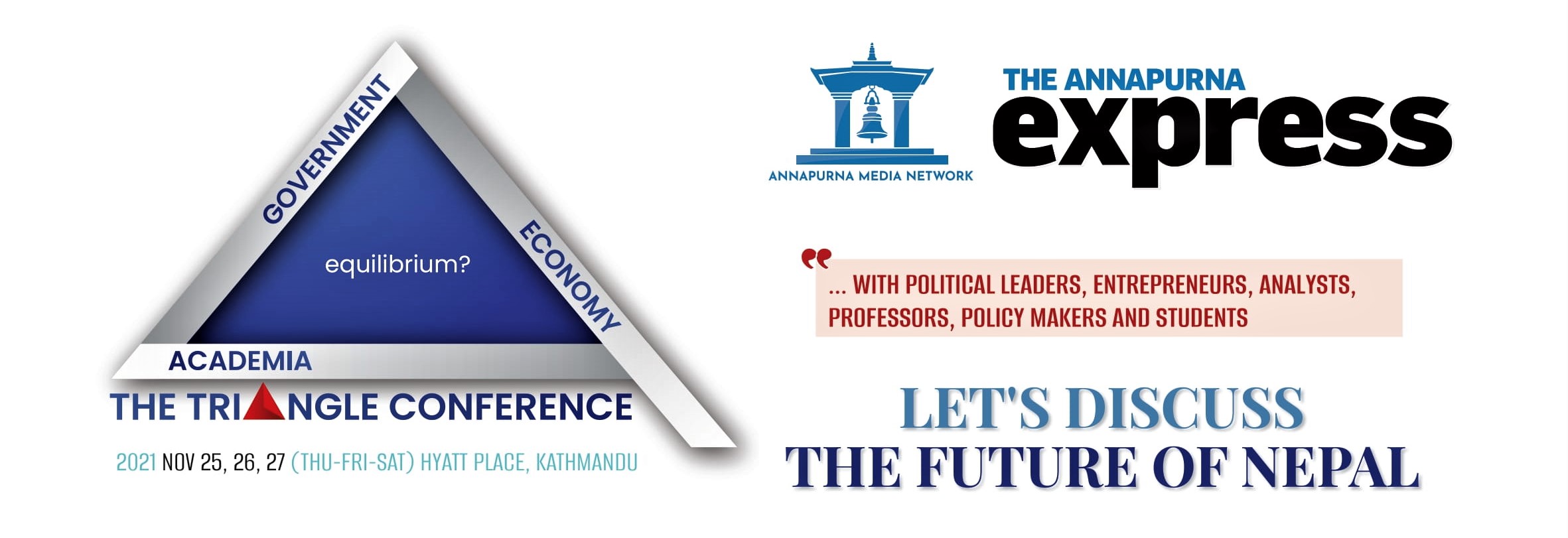
Day I
The first session on national capabilities and necessities had panelists discuss the situation of academia and its link with economic development. The session, moderated by Jagannath Lamichhane, saw the participation of Kewal Bhandari, Secretary, the National Planning Commission. “It is the job of the government to bring out policies to promote the private sector and we are doing that,” said Bhandari. Panelist Sunaina Ghimire Pandey, managing director of General Technology Pvt Ltd, asked the government to establish an exclusive university for the IT sector.
Saurav Karkee, an IT student who attended the conference, agreed with Pandey. “The present and future of the nation depend on IT, so policies must revolve around this sector.”
Also read: The Triangle Conference: Righting the government-academia-business mismatch
The second session discussed the post-pandemic mental health of youths and the workforce population. Panelists discussed how youths can develop a positive mentality and contribute to the national economy.Hosted by Shreeya Giri, founder of Happy Minds, guests in the session shared their pandemic-related experiences. Comedian Manoj Gajurel, who was infected with Covid-19, said it was his positive mental energy that helped him recover. Similarly, Dr Rishav Koirala, psychiatrist at Grande Hospital said, “We need to teach mental health wellness as a subject in school.” Gajurel further added, “Parents should be aware before making their children aware of mental health wellness.”
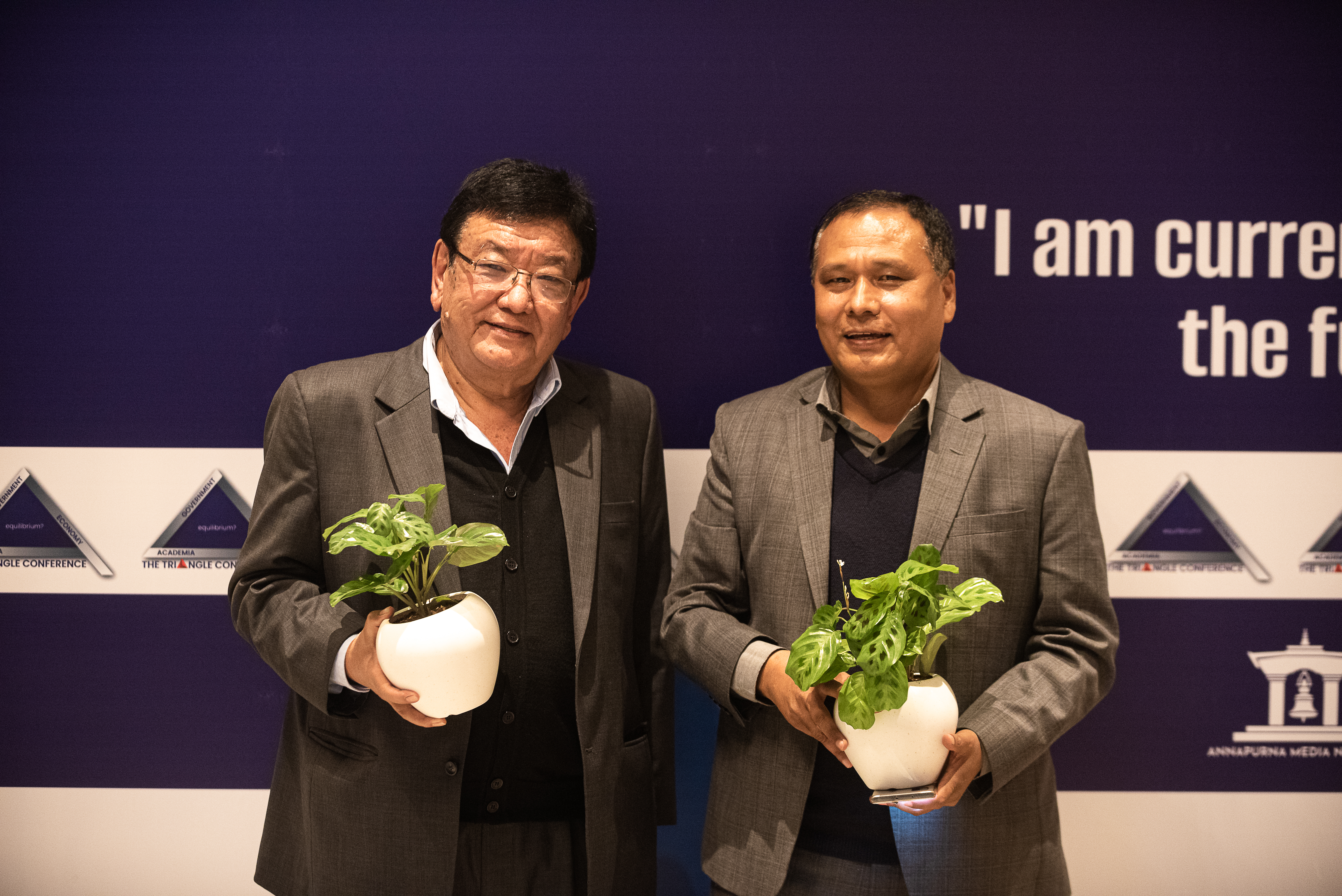
The last session of the first day was conducted by Chief Editor of AP1 HD television, Tikaram Yatri. It discussed the role of leadership in nation-building. Dr Sanduk Ruit, senior eye surgeon, said ‘integrity’ was the key thing he expects from his team. “Without a synergy between the team and the leader, development is not possible as the two complement each other,” Kulman Ghising, managing director of Nepal Electricity Authority, said, while agreeing with Ruit.
Day II
The second day started with a panel discussion on the gaps between the needs and expectations of the government, economy, and academia. The session was moderated by ApEx Editor-in-Chief Biswas Baral. During the session, Sohan Sha, a researcher at Martin Chautari accused Tribhuvan University of failing the system and the country. Kusum Shakya, another participant, said, “Political and economic revolution must go hand in hand.”
Bhim Prasad Subedi, chairman of the University Grants Commission, highlighted the need for political consensus to improve the education system.
Also read: The Triangle Conference: Let’s discuss the future of Nepal
“This session helped me a lot because it talked about the mess that our public universities are in,” says Parbati Dahal, a secondary-level teacher. “I learned that those who should be leading the country are instead taking it backwards.”
As elections are round the corner, ApEx also organized a session on political parties and electoral governance. ApEx Assistant Editor Kamal Dev Bhattarai moderated the panel discussion which had veteran journalist Yogesh Dhakal asking for the source of funds for CPN-UML’s Rs 15 million-general convention. Similarly, Neel Kantha Uprety, former chief election commissioner, said, “Political parties buy their way to power through elections.”
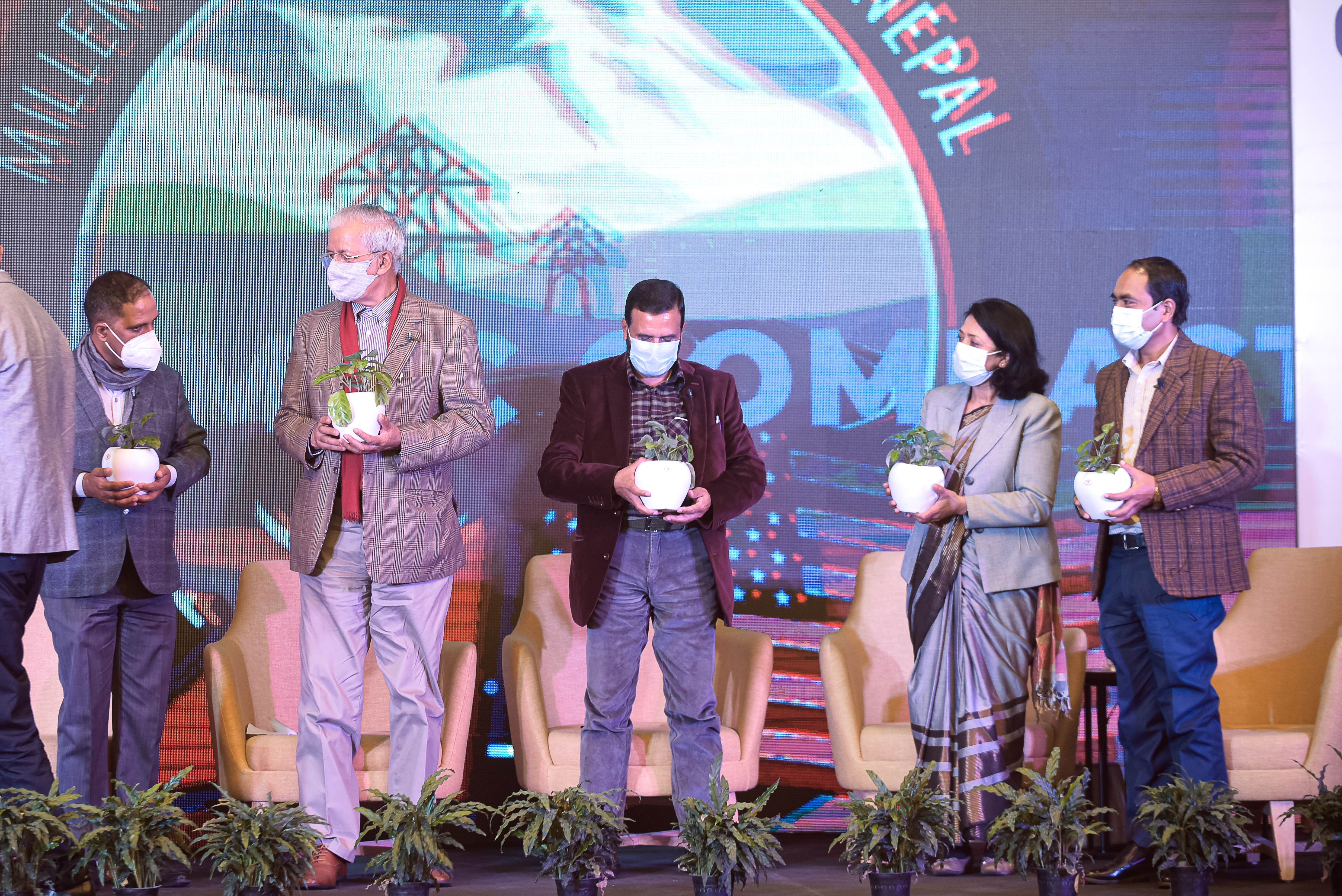
In the same session, Bimala Rai Poudel, a member of the National Assembly, defended lawmakers who won elections under the proportional system. She said, “Not all those elected through PR are corrupt and incompetent.”
Day III
The last day of the conference focused on leadership and the workforce.
The first session moderated by ApEx journalist Pratik Ghimire saw Anjana Bishankhe, member of parliament from CPN (Maoist Center), quote Mao’s definition of leadership. She said, “Leaders are those who are creative and farsighted but they also work with the public.” Devendra Pokharel, founder of Cocina Mitho Chha, asked leaders in all sectors to set examples. Similarly, Dr Tshering Lama of Idea Studio Nepal said, “There is a huge gulf between the confidence and competence in our leaders.”
Also read: AMN launches ‘Unity for Sustainability’ campaign
The second session, moderated by ApEx Assistant Editor Kamal Dev Bhattarai was named ‘Workforce 2025’. There, the panelists talked about the traits, ideas, characteristics, competencies, concepts of the workforce Nepal needs by 2025.
Dr Jeevan Baniya, a researcher in the same sector, said 84 percent of Nepali workforce are engaged in the informal economy. While Anil Muni Bajracharya said, “We lack demand-side education and also, vocational jobs are highly undervalued in Nepal.”
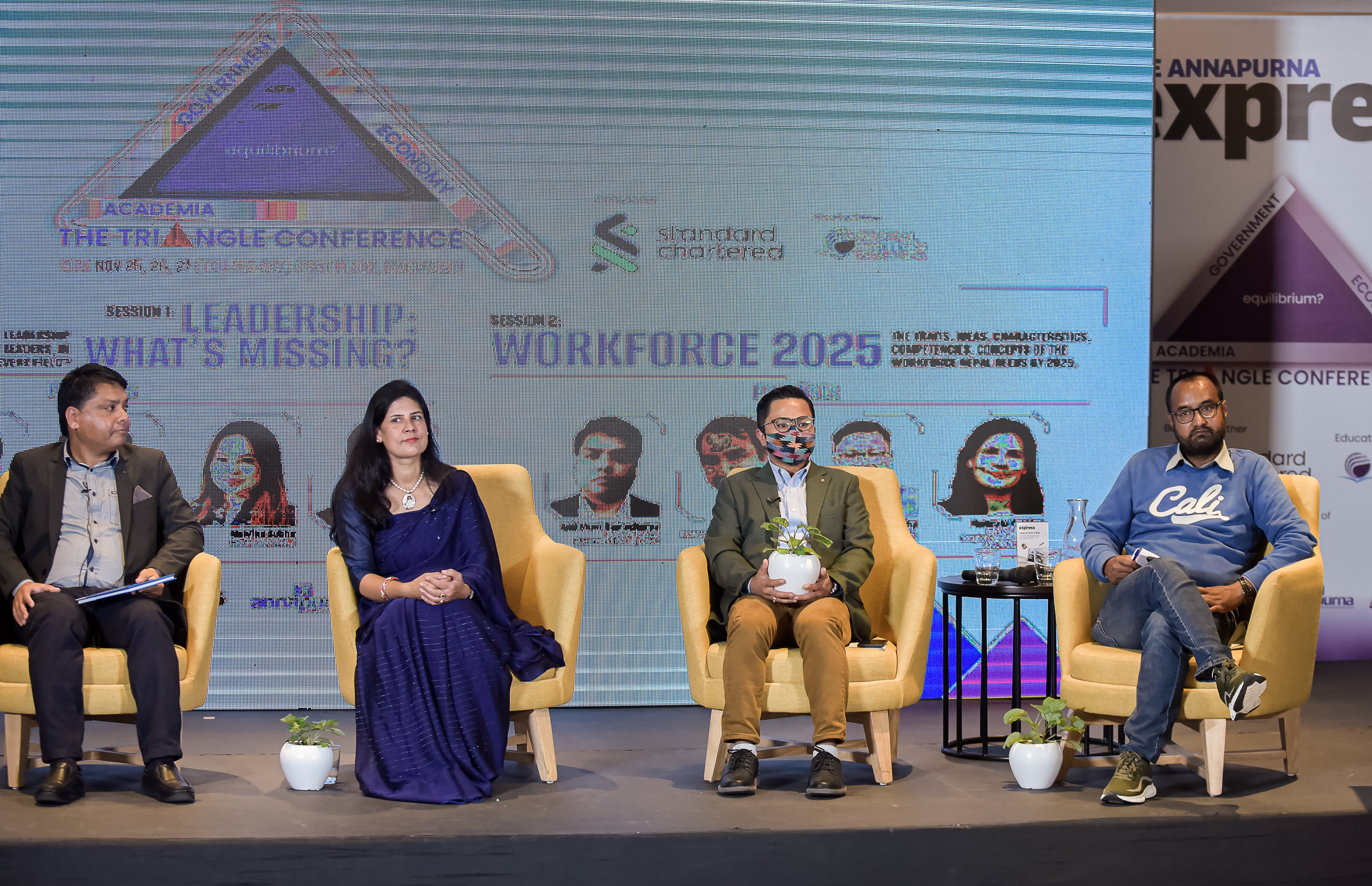
Pradyumna Raj Pandey, under-secretary at the Ministry of Agriculture and Livestock Development, said, “This kind of program will help all concerned parties to communicate with one another. I wish there would be more representation from the government sector in the days to come as they are the key to change.”
Rupak Sapkota: Time has come for a ‘neutral zone of peace’ idea
Rupak Sapkota has just ended his tenure as the Deputy Executive Director at Institute of Foreign Affairs (IFA). A Phd in International Relations from Renmin University of China, Sapkota is among Nepal’s most-promising young foreign policy experts with a specialization in security and geopolitical studies. Pratik Ghimire of ApEx talked to him about Nepal’s changing foreign policy picture.
What are the key foreign policy challenges for Nepal?
The rise of China as a strong power center and its competition with the US, which had alone dominated world affairs for decades, has changed global geopolitics. As the US proposes different strategies to continue its dominance, a new cold war is simmering between these two giants. For Nepal, China’s immediate neighbor, this cold war will pose many challenges.
China and India currently have a war-like situation at their border. Further, India has embraced close ties with the US, and together, they have formed geopolitical alliances and strategies such as the IPS (Indo-pacific Strategy) and QUAD, both of which seem directed against China. It will be immensely challenging for Nepal to stay out of all this.
Should Nepal then review its non-aligned foreign policy accordingly?
Nepal’s non-aligned foreign policy was a result of the Cold War between the US and the USSR. And the policy has been with us for almost seven decades. I won’t say it has lost its relevance, but it is certainly not enough. To meet the challenges posed by current world politics and our ambitions for development, a non-aligned foreign policy alone does not sufficiently address our priorities. So, while continuing our nonalignment, we must also look to preserve, promote, and expand our strategic autonomy.
How do you see the ‘MCC vs BRI’ debate in Nepal?
Both the ideas were viewed with the economic lens early on, but later, with great geopolitical shifts, both were heavily politicized. Because of this, we have failed to make a headway on either.
Also, small states like Nepal are more cautious on their foreign policy, diplomacy, and security. So, to settle this ‘MCC vs BRI’ debate, political leaders and experts should convince the public about both, and future decisions must keep public interest at heart.
You suggested a recalibration of Nepal’s foreign policy. How do you do that?
By endorsing and updating our non-aligned foreign policy and the principles of Panchsheel, we can enhance our relations with other countries to gain strategic autonomy and achieve economic development. And most importantly, every diplomatic approach must prioritize our wellbeing amid the climate crisis and the Covid-19 pandemic. We must stay away from any military- and security-related projects and alignments.
In 1970, Nepal proposed to declare itself a ‘zone of peace’. Do you think we should give it another go?
In the present geopolitical context, declaring the country a ‘zone of peace’ alone won’t mitigate our foreign policy threats. Along with it, this is the time to endorse a neutralist policy because we might witness a confrontation between our neighboring countries soon and, during those times, we will have to make our stance clear.
The Triangle Conference: Righting the government-academia-business mismatch
Sanothimi, Bhaktapur is dotted with many governmental offices, mainly related to education and training. A particularly colorful three-storey building in the area belongs to the Council for Technical Education and Vocational Training (CTEVT), which falls under the Ministry of Education, Science, and Technology. Oddly though, the colorful office seems impervious to outsiders.
The motto of this office is: ‘Skilling Nepal for People’s Prosperity’. The education minister is the chairperson of CTEVT while the vice-chair is appointed by the Cabinet. In other words, it’s pretty much filled with political appointees. According to the government of Nepal, “CTEVT is a national autonomous apex body for technical and vocational education and training committed to the production of technical and skillful human resources required for the nation.” This is exactly why we wanted to contact them.
We could not. There was no one to pick up the three different phone numbers listed on CTEVT website, during office hours, but all lines were busy, all the time. This is just an example of the kind of dysfunction and unresponsiveness that characterise our academic and vocational education establishments.
The number of ‘educated unemployed’ in Nepal is increasing by the day. Graduates are struggling to land good jobs while organizations, both public and private, fail to fill vacancies. Our academia appears incapable of producing qualified human resources.
Are our businesses and industries not investing enough in human resource development? Or is it the state’s failure to come up with the right policies, programs, and incentives? But there is no good answer on offer. The education ministry is largely out of reach. Just like at the CTEVT, all your attempts to contact ministry officials will be futile.
Also read: The Triangle Conference: Let’s discuss the future of Nepal
Yes, the government is unresponsive, says Shekhar Golchha, president of the Federation of Nepalese Chambers of Commerce and Industry (FNCCI), but the private sector is doing its bit to improve things. For instance, the FNCCI is undertaking a research titled ‘Ilam’, which is now in its final phase. “We were researching the type of human resources the industry needs and the kind the academia is capable of providing,” he says after agreeing that there is indeed a lot of job-skill mismatch.
Lok Raj Baral, a political scientist, blames the political parties and politicians for the mess. “Both the universities and the private sector are badly politicized,” he says.
For Golchha, the solution to this crisis is not far-fetched. Only if the education ministry, CTEVT, and other concerned bodies took their research seriously, the private sector would get qualified and sufficient manpower, he says. And for Baral, politics is primary, so it should be purified in the first place.
With all these problems in the country, the youth either end up in no-prospect jobs or head abroad.
Even as the country faces all these problems, stakeholders are mum. In the absence of meaningful dialogue between them, the government, the academia and the private enterprises are each pursuing their own goals. But only when all these sectors align can the country develop, while even a little non-alignment can disrupt the entire system.
‘The Triangle Conference: Let’s discuss the future of Nepal’ (November 25-27) is a platform initiated by The Annapurna Express to get these stakeholders talking and hasing out their differences so that they can work in mutually beneficial ways.
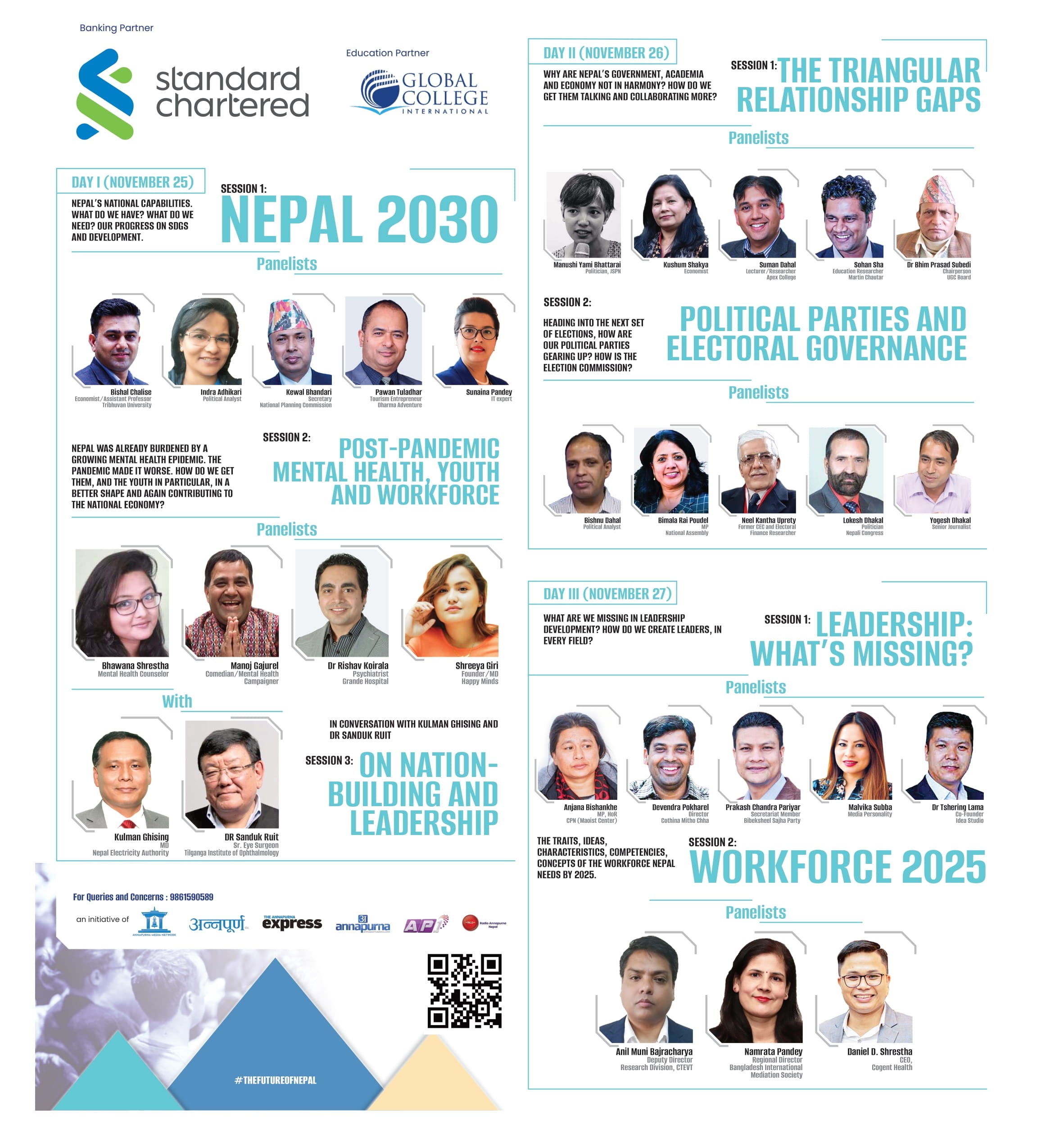
During the seven sessions spread over three days, politicians, bureaucrats, academics, private sector representatives, student leaders and other representatives from the three sectors will discuss the gaps in their communication, their future vision for Nepal, entrepreneurship, leadership, and policy issues.
“We lack the blueprint of planning”
Shyam Shrestha, former member of the High-Level National Education Commission
We lack proper nationwide planning on the quality and quantity of human resources we need in each sector. This is largely due to the inaction of the National Planning Commission (NPC) whose job it is to coordinate with all sectors and plan for them.
When I was at the education commission, I found that our national needs and the manpower we produce are poles apart. We informed the government about this, but nobody cared. We lack a blueprint for proper planning.
We produce educated manpower of international standard, but due to mismanagement they end up going abroad. This is a substantial loss for us, both economically and psychologically.
We think we are more developed than Bhutan, but Bhutan is miles ahead in terms of planning for the human resources it needs.
Vijay Bajimaya obituary: Legendary litterateur from lake-city
Birth: 5 April 1958, Kaski
Death: 14 November 2021, Kathmandu
In the darkness of the stage at Sarbanam Theater, as the spotlight was turned on, the audience could see just two things. One was a calendar with ‘2014’ written on it and another, in front of it, poet Vijay Bajimaya sitting in his wheelchair. As light gleamed on his wrinkled forehead, Bajimaya recited his poems and, in between, narrated the struggles of his public as well as personal lives.
Until the age of five, Bajimaya was physically fit. But, he was then trampled on by a horse and his legs suffered injuries. He still used to play and run but slowly—with more minor accidents—he couldn’t move his legs and had to resort to a wheelchair. But this didn’t stop his literary progression, nor did it stop him from making the most of his political, social, and business life.
His friendship and close relations with poets and writers inspired him to write. Celebrated litterateurs Sarubhakta, Jagadish Ghimire, Indra Mali, Tirtha Shrestha were his friends and relatives who helped Bajimaya throughout his literary journey.
Also read: Bhairav Prasad Lamsal obituary: The anti-corruption crusader
Inspired by his friends, Bajimaya started his professional writing career with the poem ‘Prajatantra’ in 1973. He then published ‘Samaya Bhaneko Samaya Ho’ (poem collection), ‘Antatwogatwo’ (story collection). He also worked as a journalist. At the age of 15 in 1972, he became the editor of ‘Fewataal’, a local newspaper. Later, he also wrote and reported for other newspapers. Bajimaya also established a public library at home.
Before the 80s, poem recitation events were open to all and there were no entry fees. But Bajimaya started implementing a ticketing system for such programs so that writers and poets also got their fair share of earnings.
After 1985, he came to Kathmandu and started a hotel.
For his evergreen contributions to Nepali literature, Bajimaya got multiple awards such as ‘Byathit Kaabya Puraskar’, ‘Yuwa Barsha Moti Puraskar’, ‘Maanshree Puraskar’, ‘Rashtriya Pratibha Puraskar’, and ‘Gazalshree’.
Bajimaya, who remained a bachelor for life, died on 14 November 2021, at the age of 63, at his residence in Kathmandu. His funeral was held in his hometown of Pokhara.














